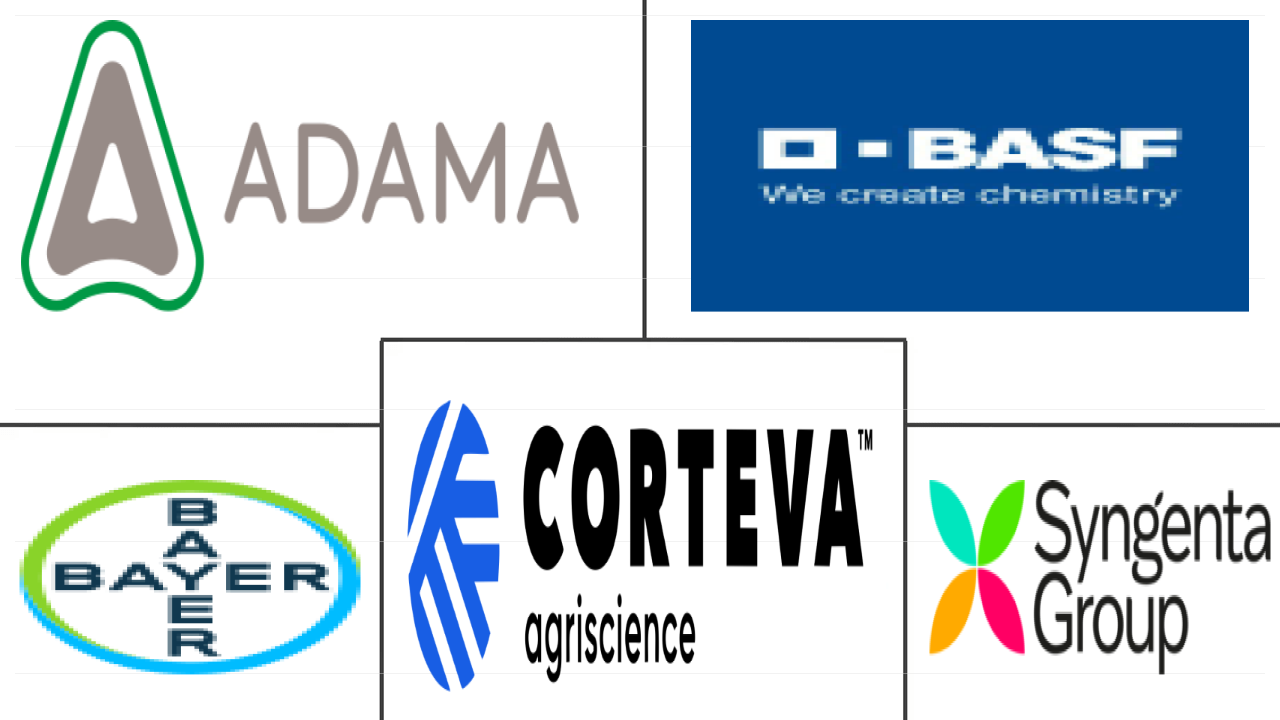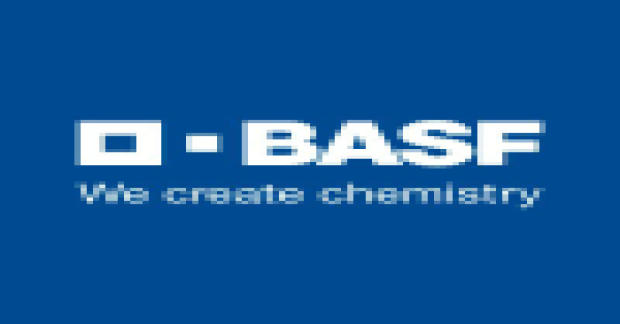Market Size of africa fungicide Industry
| Icons | Lable | Value |
|---|---|---|
|
|
Study Period | 2017 - 2029 |
|
|
Market Size (2024) | USD 1.03 Billion |
|
|
Market Size (2029) | USD 1.19 Billion |
|
|
Largest Share by Application Mode | Foliar |
|
|
CAGR (2024 - 2029) | 2.90 % |
|
|
Largest Share by Country | South Africa |
|
|
Market Concentration | Low |
Major Players |
||

|
||
|
*Disclaimer: Major Players sorted in no particular order |
Africa Fungicide Market Analysis
The Africa Fungicide Market size is estimated at 1.03 billion USD in 2024, and is expected to reach 1.19 billion USD by 2029, growing at a CAGR of 2.90% during the forecast period (2024-2029).
1.03 Billion
Market Size in 2024 (USD)
1.19 Billion
Market Size in 2029 (USD)
5.15 %
CAGR (2017-2023)
2.90 %
CAGR (2024-2029)
Largest Segment by Application Mode
60.96 %
value share, Foliar, 2023
This method ensures that the fungicide reaches the pest populations effectively and minimizes exposure to non-target organisms by acting before the infection establishes.
Largest Segment by Crop Type
45.74 %
value share, Grains & Cereals, 2023
Maize is a major food crop grown in diverse agricultural zones and farming systems of Sub-Saharan Africa, with major fungal diseases causing yield loss of up to 40-60%.
Largest Segment By Country
27.98 %
value share, South Africa, 2023
South Africa has a market-oriented agricultural economy that is highly diverse and includes major grains, oilseeds, deciduous and subtropical fruits, and vegetables.
Leading Market Player 1
7.20 %
market share, Syngenta Group, 2022

Syngenta developed the Vayantis seed treatment fungicide, which contains picarbutrazox, a new active ingredient that addresses the grower's needs in oilseeds and cereals.
Leading Market Player 2
6.25 %
market share, BASF SE, 2022

BASF SE is increasing its R&D efforts in the field of sustainable agriculture and focusing on creating novel solutions to overcome environmental issues.
The growing focus on protecting the yield and avoiding crop losses due to disease infestation is driving the market
- In 2022, the foliar segment held a significant share, which is expected to grow the fastest among applications with a 3.0% CAGR during the forecast period. This segment's growth is driven by the increased advantages of foliar use due to its systemic effect and compatibility with other treatments.
- Seed treatment holds the second-largest market share and is projected to record a 2.8% CAGR during the forecast period (2023-2029). Farmers in the country have adopted a common practice of pesticide seed treatment to improve seed performance and protect against diseases.
- Chemigation accounted for 12.3% of the African fungicide market value in 2022. This method is projected to record a 2.6% CAGR during the forecast period. In Africa, farmers are experiencing growing agricultural productivity as a result of adopting an irrigation system. This is likely to stimulate the growth of this segment over the coming years.
- The soil treatment method is anticipated to register a 2.7% CAGR during the period 2023-2029. The adoption of such application techniques was high among farmers in the region due to its various benefits, for instance, growers being able to control soil pests and those attacking aerial parts of the plant with a systemic fungicide.
- Studies have shown that fumigants are highly effective in controlling diseases and improving yields by protecting against soil-borne diseases. For instance, dazomet (DZ) fumigation was found to be 89.62% to 93.33% effective against fusarium and phytophthora. Due to these factors, the demand for fumigants is expected to increase.
- The fungicide market is projected to record a 2.9% CAGR during the period 2023-2029. African farmers are adopting different methods based on their requirements to protect crops and ensure optimal yields.
Increased awareness among farmers for using fungicides to protect crops is boosting the market
- The fungicide market in Africa witnessed steady growth during the historical period, with the region occupying a share of 27.3%, by value, of the total crop protection chemical market in 2022. Mancozeb and systemic fungicides such as metalaxyl and benzimidazoles are the most frequently used fungicides in the region.
- Maize is the most important staple crop cultivated throughout Africa, with leading maize-producing countries being Nigeria, South Africa, and Ethiopia. Fungicides are mostly used in grains and cereals in the region as it is the largest exporter and producer of staple grains such as maize and wheat. The segment occupied a share of 45.8%, by value, in 2022.
- Similarly, 97% of yam is produced in the West African countries of the region. Anthracnose disease of yam is the most devastating fungal disease, leading to 50–90% losses. The control of yam anthracnose has been accomplished mainly with chemical fungicides such as benomyl (benlate), maneb, chlorothalonil, and mancozeb, which require biweekly or monthly applications.
- The occurrence of fungicide resistance presents a big challenge as it limits fungicide choices for effective disease management. At the same time, governments of various countries are investing in research initiatives to discover new diseases and their subsequent fungicides, along with supportive schemes for farmers.
- Such policies initiated by the government and a rise in awareness among farmers have further encouraged farmers to adopt crop protection practices that aim to expand the market, which is anticipated to record a CAGR of 2.9% during the forecast period (2023-2029).
Africa Fungicide Industry Segmentation
Chemigation, Foliar, Fumigation, Seed Treatment, Soil Treatment are covered as segments by Application Mode. Commercial Crops, Fruits & Vegetables, Grains & Cereals, Pulses & Oilseeds, Turf & Ornamental are covered as segments by Crop Type. South Africa are covered as segments by Country.
- In 2022, the foliar segment held a significant share, which is expected to grow the fastest among applications with a 3.0% CAGR during the forecast period. This segment's growth is driven by the increased advantages of foliar use due to its systemic effect and compatibility with other treatments.
- Seed treatment holds the second-largest market share and is projected to record a 2.8% CAGR during the forecast period (2023-2029). Farmers in the country have adopted a common practice of pesticide seed treatment to improve seed performance and protect against diseases.
- Chemigation accounted for 12.3% of the African fungicide market value in 2022. This method is projected to record a 2.6% CAGR during the forecast period. In Africa, farmers are experiencing growing agricultural productivity as a result of adopting an irrigation system. This is likely to stimulate the growth of this segment over the coming years.
- The soil treatment method is anticipated to register a 2.7% CAGR during the period 2023-2029. The adoption of such application techniques was high among farmers in the region due to its various benefits, for instance, growers being able to control soil pests and those attacking aerial parts of the plant with a systemic fungicide.
- Studies have shown that fumigants are highly effective in controlling diseases and improving yields by protecting against soil-borne diseases. For instance, dazomet (DZ) fumigation was found to be 89.62% to 93.33% effective against fusarium and phytophthora. Due to these factors, the demand for fumigants is expected to increase.
- The fungicide market is projected to record a 2.9% CAGR during the period 2023-2029. African farmers are adopting different methods based on their requirements to protect crops and ensure optimal yields.
| Application Mode | |
| Chemigation | |
| Foliar | |
| Fumigation | |
| Seed Treatment | |
| Soil Treatment |
| Crop Type | |
| Commercial Crops | |
| Fruits & Vegetables | |
| Grains & Cereals | |
| Pulses & Oilseeds | |
| Turf & Ornamental |
| Country | |
| South Africa | |
| Rest of Africa |
Africa Fungicide Market Size Summary
The Africa fungicide market is experiencing steady growth, driven by the increasing adoption of various fungicide application methods to protect crops and enhance yields. The market is characterized by a diverse range of environmental conditions across the continent, which contribute to the prevalence of fungal diseases affecting staple crops such as maize, cassava, and yam. The foliar application segment is anticipated to grow rapidly due to its systemic effects and compatibility with other treatments, while seed treatment and chemigation also hold significant market shares. The use of fumigants is expected to rise, given their effectiveness in controlling soil-borne diseases. The market's expansion is further supported by government initiatives and increased awareness among farmers about the benefits of crop protection practices.
Commercial farming is on the rise in Africa, with larger-scale operations and the cultivation of high-value cash crops driving the demand for fungicides. Key fungicides used in the region include mancozeb, azoxystrobin, and metalaxyl, which are essential for combating various fungal diseases threatening crops. The market is fragmented, with major players like ADAMA Agricultural Solutions Ltd, BASF SE, Bayer AG, Corteva Agriscience, and Syngenta Group holding significant shares. Recent developments, such as Bayer's partnership with Oerth Bio and Corteva's introduction of Zorvec Encantia, highlight ongoing efforts to enhance crop protection technologies. Despite challenges like fungicide resistance, the market is poised for growth, supported by continuous research and development in plant protection solutions.
Africa Fungicide Market Size - Table of Contents
-
1. MARKET SEGMENTATION (includes market size in Value in USD and Volume, Forecasts up to 2029 and analysis of growth prospects)
-
1.1 Application Mode
-
1.1.1 Chemigation
-
1.1.2 Foliar
-
1.1.3 Fumigation
-
1.1.4 Seed Treatment
-
1.1.5 Soil Treatment
-
-
1.2 Crop Type
-
1.2.1 Commercial Crops
-
1.2.2 Fruits & Vegetables
-
1.2.3 Grains & Cereals
-
1.2.4 Pulses & Oilseeds
-
1.2.5 Turf & Ornamental
-
-
1.3 Country
-
1.3.1 South Africa
-
1.3.2 Rest of Africa
-
-
Africa Fungicide Market Size FAQs
How big is the Africa Fungicide Market?
The Africa Fungicide Market size is expected to reach USD 1.03 billion in 2024 and grow at a CAGR of 2.90% to reach USD 1.19 billion by 2029.
What is the current Africa Fungicide Market size?
In 2024, the Africa Fungicide Market size is expected to reach USD 1.03 billion.

